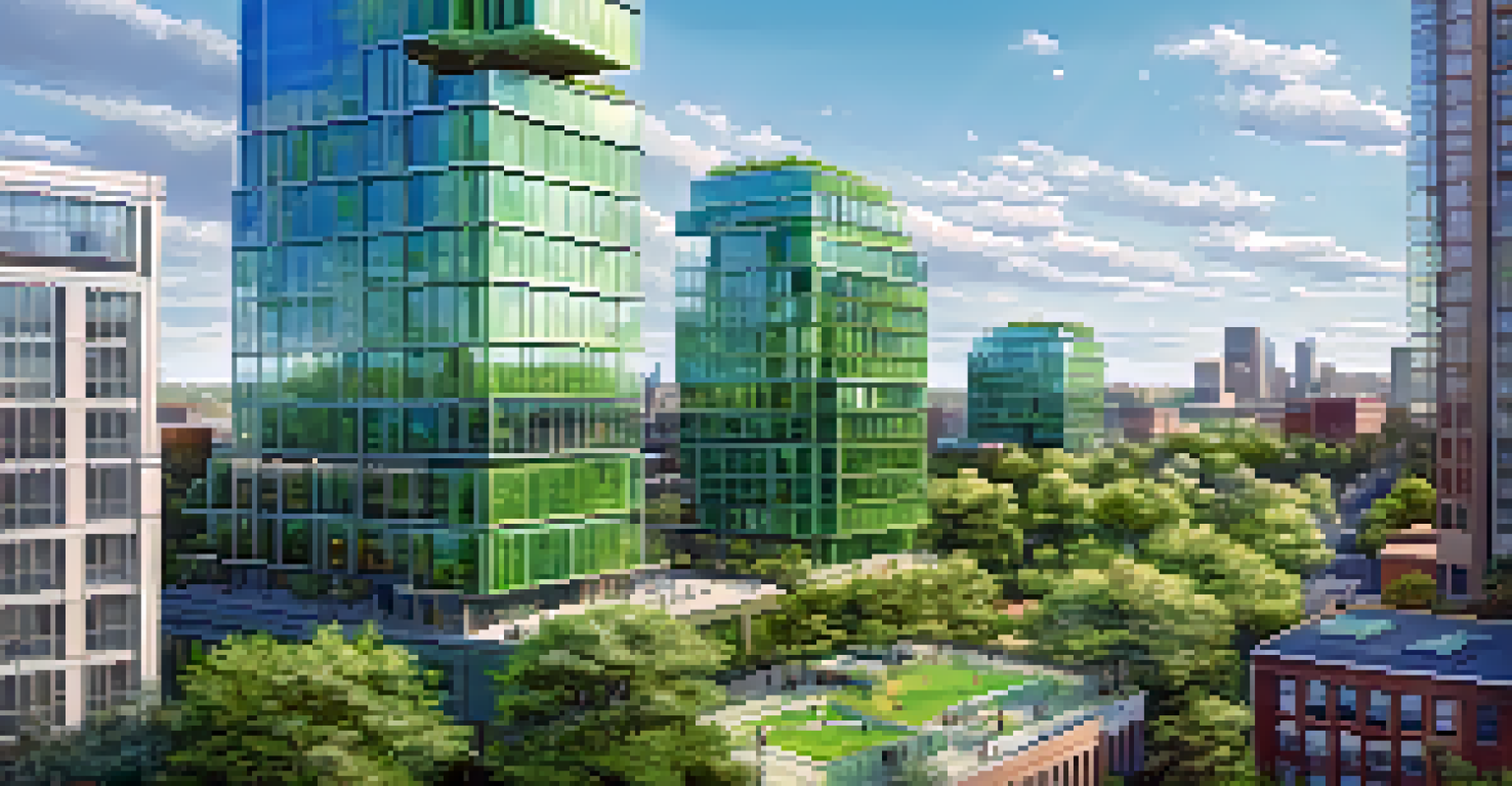Buffalo's Green Building Movement: Sustainable Architecture

Introduction to Buffalo's Green Building Movement
Buffalo, once known for its industrial prowess, is now becoming a beacon for sustainable architecture. The city's green building movement is reshaping its skyline and environment, emphasizing the importance of eco-friendly designs. This initiative not only focuses on reducing the carbon footprint but also aims to create healthier living spaces for residents.
Sustainability is no longer about doing less harm. It's about doing more good.
The movement is part of a broader trend towards sustainability in urban planning, where cities worldwide are rallying to mitigate climate change impacts. In Buffalo, this focus is palpable, with various projects showcasing innovative green designs. From energy-efficient buildings to the use of renewable materials, the city is paving the way for a greener future.
As more architects and developers embrace these principles, Buffalo is setting an example of how urban areas can prioritize sustainability without sacrificing aesthetic appeal. By integrating nature into urban spaces, the city is enhancing both its ecological and social fabric.
Key Principles of Sustainable Architecture
Sustainable architecture revolves around several core principles, including energy efficiency, resource conservation, and environmental stewardship. These principles guide architects and builders in designing structures that minimize environmental impact. For instance, utilizing renewable resources, like solar panels and sustainably sourced materials, is becoming increasingly common in Buffalo's new developments.

Another crucial aspect is the concept of 'green roofs' or living roofs, which not only improve insulation but also contribute to biodiversity in urban settings. These roofs are adorned with vegetation that helps manage stormwater runoff, reduce heat islands, and enhance air quality. By incorporating such features, buildings are not just structures but ecosystems in their own right.
Buffalo's Eco-Friendly Transformation
Buffalo is leading a green building movement that prioritizes sustainable architecture and healthier living spaces.
Moreover, sustainable architecture emphasizes the importance of community engagement. By involving local residents in the design process, architects can create spaces that reflect the needs and desires of the community. This collaborative approach ensures that sustainability is not just a trend but a shared value in Buffalo.
Notable Green Buildings in Buffalo
Buffalo boasts several remarkable green buildings that exemplify sustainable design. One standout is the Buffalo-Niagara Medical Campus, which integrates cutting-edge eco-friendly technologies. This campus not only serves as a hub for healthcare but also showcases how modern architecture can harmonize with nature.
The environment is where we all meet; where we all have a mutual interest; it is the one thing all of us share.
Another impressive example is the Albright-Knox Art Gallery expansion, which features sustainable design elements like high-performance glazing and energy-efficient lighting. This building enhances the gallery's aesthetic while minimizing its environmental footprint, proving that art and sustainability can coexist beautifully.
Additionally, the new Buffalo City Hall renovation includes green initiatives such as improved insulation and energy systems. These transformations reflect a commitment to sustainability, demonstrating that even historic buildings can embrace modern eco-friendly practices.
The Role of Local Government in Promoting Sustainability
Local government plays a pivotal role in promoting sustainable architecture through policies and incentives. Buffalo has established green building codes that encourage developers to adopt eco-friendly practices. These regulations not only streamline the permitting process for green projects but also provide financial incentives, making it easier for builders to invest in sustainability.
The city also collaborates with organizations to promote educational programs about the benefits of green building. Workshops and seminars help both builders and the public understand the importance of sustainable practices, fostering a culture of environmental responsibility. This proactive approach has led to an increase in sustainable projects across the city.
Community Engagement Drives Success
Active involvement from residents and local organizations is crucial in shaping Buffalo's sustainable development initiatives.
Moreover, Buffalo's commitment to sustainability extends to its infrastructure. Investments in public transportation and green spaces encourage residents to adopt a more sustainable lifestyle. By prioritizing these initiatives, the local government is setting a strong foundation for a greener Buffalo.
Community Involvement in the Green Building Movement
Community involvement is essential for the success of Buffalo's green building movement. Residents, local organizations, and businesses are actively participating in initiatives that promote sustainability. This grassroots effort ensures that the community's voice is heard in the development process, leading to more inclusive and relevant designs.
Neighborhood associations play a vital role in advocating for eco-friendly practices and engaging residents in sustainability efforts. Events such as tree plantings and clean-up drives not only beautify the city but also raise awareness about the importance of environmental stewardship. These initiatives foster a sense of community ownership and pride in Buffalo's sustainable future.
Furthermore, local schools are incorporating sustainability into their curricula, teaching the next generation about the importance of green living. By instilling these values early on, Buffalo is nurturing a community that values and prioritizes sustainability in all aspects of life.
Challenges Facing the Green Building Movement
Despite the progress, Buffalo's green building movement faces several challenges. One significant hurdle is the initial cost associated with green construction, which can deter developers from pursuing eco-friendly projects. While long-term savings on energy bills are substantial, the upfront investment can be a barrier, especially for smaller developers.
Additionally, there is often a lack of awareness among the general public regarding the benefits of sustainable architecture. Educating residents about the advantages of eco-friendly buildings is crucial for gaining support for these initiatives. Without public buy-in, it can be challenging to sustain momentum in the green building movement.
Challenges to Green Building Growth
Despite progress, Buffalo faces challenges such as high initial costs and regulatory hurdles that could hinder its green building movement.
Finally, regulatory hurdles can pose challenges for developers looking to implement innovative designs. Navigating building codes and zoning laws can be complex, and without clear guidelines, many may shy away from pursuing green building certifications. Addressing these challenges is essential for the continued growth of Buffalo's sustainable architecture.
The Future of Buffalo's Green Building Movement
Looking ahead, Buffalo's green building movement holds great promise. As awareness of climate change increases, there is a growing demand for sustainable architecture. This shift in mindset is likely to drive more developers to embrace eco-friendly practices, leading to a healthier urban landscape.
Emerging technologies in building materials and energy systems will also play a crucial role in shaping the future of sustainable architecture. Innovations such as carbon-neutral concrete and advanced energy storage solutions can significantly enhance the efficiency of new buildings. Buffalo is well-positioned to be at the forefront of these advancements.

Moreover, as more cities adopt sustainable practices, Buffalo can learn from these experiences and adapt successful strategies. This collaborative approach can foster a vibrant network of cities committed to sustainability, creating a ripple effect that benefits not only Buffalo but the broader region and beyond.